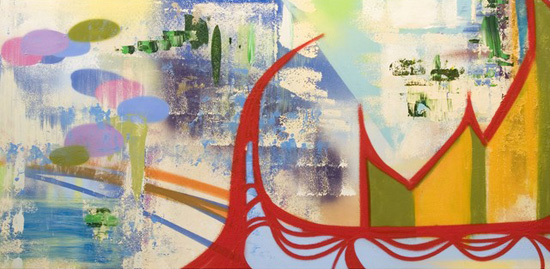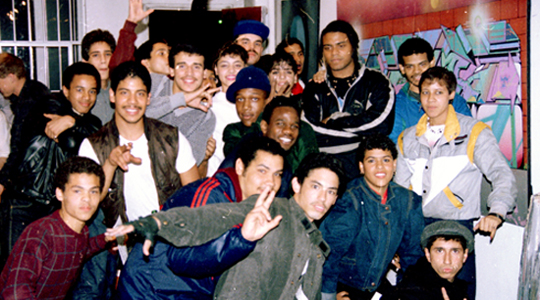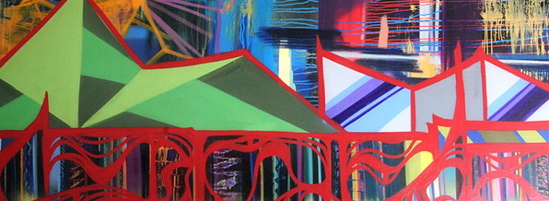SpearTalks: Vulcan

Thirty years ago, when graffiti was withheld the respect of the subtitle "Art Form," a twelve year-old Vulcan hit the subway cars of New York with his collection of wildly colored paintcans. Over thirty years — and countless walls, trains, and buses — later, the now San Francisco-based graffiti legend has made a smooth transition from street to START SOMA, where the artist-in-residence uses his decades of experience to continue doing what he's done all along — create some of the most significant works of art, both street and otherwise, this side of 1973.
We chatted with Vulcan about his graffiti past and his gallery present, and came out the other side in agreement with the artist: Corporate or communal, gallery or "˜getting up'; art is art, and making it is what truly matters.
Joshspear.com: As one of the earlier writers, what graffiti represents to you is probably somewhat different than what it represents to today’s newest artists. Has any important meaning been lost over the years?
Vulcan: When I was 12 years old in Harlem, I wanted to CREATE. But options were pretty limited – scavenged paint cans and public surfaces were pretty much my only options. Throughout my teens, I painted wherever and whatever I could – buses, subway trains, city walls. I painted my name. I painted giant robots. I planned ‘masterpieces’ in my notebooks at school, and horded paint cans until I had literally hundreds of colors. But I didn’t call what I was doing ‘graffiti’. I was just painting. As I honed my technical skills and found my voice, at some point I was making ART – but it was never a conscious progression.
JS: In the early nineties, it was easier to put up work that was fresh and revolutionary then it currently seems to be. What do you think it would take in order for one of today’s graffiti artist to break new ground?
V: I believe that some of the most significant art in the world today is appearing first on the streets. Artists like SABER and REVOK are doing some amazing things with color and line and letterforms. These guys are killing it on the streets and in the galleries and with corporate projects – like AWR’s work with Boost Mobile. These guys are ‘getting up’ using EVERY available modality, and I can respect that. They know the history, respect the culture, and are technically innovative. Even today, when it seems that every art student who ever picked up a can of spray paint has a self-congratulatory website and their own t-shirt company, fresh and revolutionary artists still manage to rise to the top.

I have worked with a lot of up-and-coming writers from around the world. Over the past few years, I have painted a number of public murals and commissions throughout the United States with CHOR BOOGIE and APEX, both of whom make spraycans do magical things and are also incredible style innovators (editor’s note: one such project was recently featured on JS). And of course, PHASE TWO, who I believe is the greatest writer of all time, is directly influencing the next generation of artists – he continues to progress and evolve, and his artwork has been consistently fresh and revolutionary for over 30 years!
JS: You said something in the interview you did for hiphop-network.com about developing as an artist – that you need to break rules, make up new ones, yet make sure it all makes sense. What do you mean by that?
V: I think of myself as an ARTIST. Not as a graffiti artist, or an aerosol artist, or a Black artist, or a street artist, or an urban artist – or any of the other inherently limiting labels that have been applied over the years. I get up every day and CREATE. I experiment. I try new things. Some work and some don’t. I am blessed to be at the point in my art career where some pretty amazing projects come my way, and whether I am painting servers for Google or a corporate mural or creating a series of cell phone wallpapers for a European mobile phone company or spraying a superburner in Bluxome Alley, to me it is ALL about making ART. I bring what I know, and strive to constantly evolve and innovate. There isn’t a rule book for this, and it is up to me to bring it all together and remain authentic to my own creative vision.

JS: Your art has certainly developed over the years — what elements in your older graffiti work have remained constant in your most recent pieces?
V: I try to keep my work saturated with color, motion, and style. I have also been working increasingly LARGE in my public murals, and I am trying to bring this sense of scale and grandeur into my gallery work. To me, it is all ART – whether it is a hundred foot superburner on the streets or a mural in an office building or a tiny jpeg on a cell phone screen. It is all about working within the inherent limitations of any given medium, doing the best work possible, and positively impacting the largest number of people.
JS: Not so long ago, mainstream America had major problems understanding graffiti. Today it has found popular acceptance, yet graffiti’s position as a rebel art form plays a huge role in its history. How has graffiti’s new position helped it (and its artists), and how has it hurt it?
V: When I started writing, there were no t-shirt deals or corporate sponsors or websites or anything of the sort. I painted for myself and for other writers. There was a purity and authenticity that was wholly devoid of commercial opportunities. These options only became available after many many years of solitary innovation.
JS: Some graff artists feel uncomfortable in a gallery setting, but you seem to have adapted well. Did it take awhile for you to make the transition from wall to canvas?
V: My early days were spent painting trains almost exclusively, then walls, and then canvas. My first gallery shows were in the early 80s at Patti Astor’s FUN GALLERY in the East Village. The Fun Gallery showcased the art that was appearing on the streets of New York City at the time, and their shows and openings featured some pretty influential artists – including Jean Michael Basquiat, Kenny Scharf, Fab 5 Freddy, Keith Haring, Zephyr, and Dondi White. Patti put me in my first group shows in New York and Switzerland almost 25 years ago, and I have always viewed galleries as just another way to get my work in front of people. I also showed at the Nico Smith Gallery in New York, and since then have had the opportunity to show my canvases in galleries around the world. My most recent solo show was at the LUGGAGE STORE GALLERY in San Francisco. This is one of my favorite galleries in the world – over the years, they have launched the careers of some pretty amazing artists, including Barry McGee, Os Gemeos, and Mark Bradford.

JS: I know there are mixed feelings in the graffiti community about entering galleries, doing collabs with cell phone companies, etc. Do you think there’s any merit to those arguments?
V: I can’t speak for anyone except myself on this topic. For me, my goal has long been to bring my art to the widest possible audience. In the beginning, it was my artwork on subway cars that received a great deal of attention. Then the murals I created for the Hall of Fame in Spanish Harlem started appearing in books and magazines around the world. Then AEROSOL KINGDOM came out (editors note: Vulcan appears on the cover and the title itself comes from an eponymous Vulcan mural). Then, the murals for Twisted Sister (editors note: Vulcan did the artwork for the multi-platinum COME OUT AND PLAY album cover). All of which led to tours and travel and shows and painting around the world. More recently, it has been gallery shows, community projects, corporate work, and digital applications and product licensing of my artwork. There was never any master plan. As I said earlier, I am an artist and I make art. The fact that a lot of people around the world get to see it is simply the icing on the cake as far as I am concerned.
JS: You’ve lectured at several universities, including Yale and NYU. What do you try to share with the students that come to hear you speak?
V: I happened to be in the right place at the right time making art with the only tools that were available to me, and over the years, I have been invited to speak about my experiences. I usually start by showing slides of some of the artists that have impacted me over the years. I also try to convey the historical significance of the artwork created by the writers who are inspired to create public art for free.
JS: Do you have any new shows coming up?
V: I have a solo show at San Francisco’s 111 MINNA GALLERY in April, a bunch of public and private murals in progress, and an international gallery tour in the planning stages for summer 2008.

